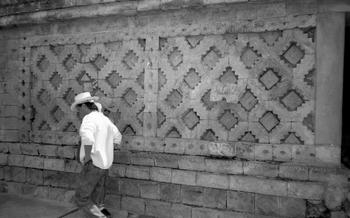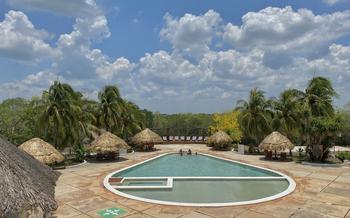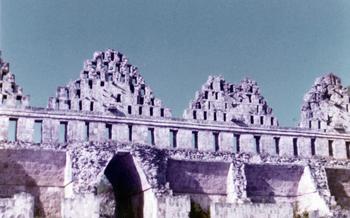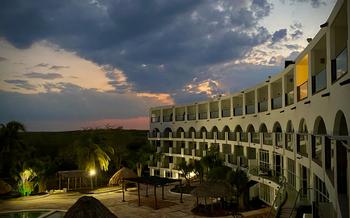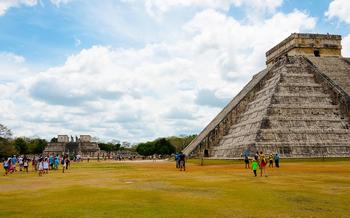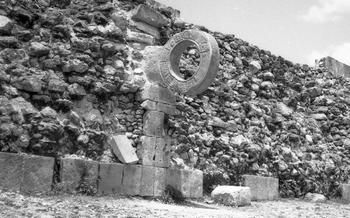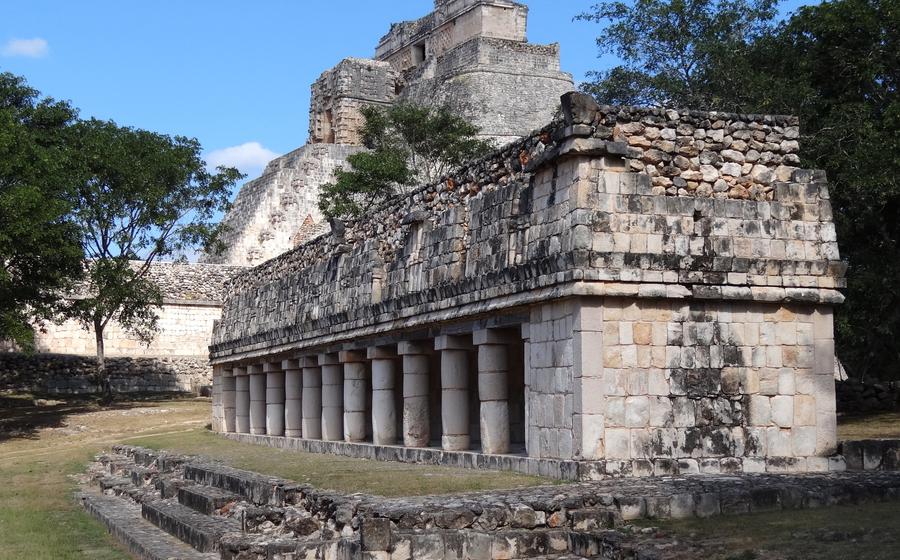
Uxmal Archaeological Site
- Uxmal: A Majestic Mayan City in the Yucatan Peninsula
- Exploring the Uxmal Archaeological Site: A Journey Through Time
- The Pyramid of the Magician: A Masterpiece of Mayan Architecture
- The Governor's Palace: A Glimpse into Mayan Elite Life
- The Great Pyramid: A Monument to Mayan Power and Prestige
- The Nunnery Quadrangle: A Sacred Space for Women
- The Ball Court: A Place for Ritual and Competition
- The Cenote Xlakah: A Sacred Water Source and Place of Pilgrimage
- The Choco-Story Museum: A Journey into the World of Chocolate
- Local Cuisine: A Culinary Adventure in Uxmal
- Shopping for Souvenirs and Handicrafts
- Accommodation Options for Every Budget:
- Insider Tip: Discovering Hidden Gems Off the Beaten Path
Uxmal: A Majestic Mayan City in the Yucatan Peninsula
Uxmal, a UNESCO World Heritage Site, stands as a testament to the ingenuity and artistry of the ancient Maya civilization. Located in the heart of the Puuc region in the Yucatan Peninsula, Mexico, Uxmal boasts a unique architectural style characterized by intricate carvings, ornate facades, and towering pyramids. Its name, meaning "built three times," reflects the city's rich history and the significance it held for the ancient Maya.
Uxmal's strategic location, nestled among rolling hills and lush vegetation, made it a prosperous center of trade and commerce. It served as the capital of an independent Maya kingdom during the Classic period (250-900 AD) and remained an important city until the Spanish conquest in the 16th century. Today, Uxmal is one of the most popular tourist destinations in the Yucatan, offering visitors a glimpse into the grandeur and splendor of the ancient Maya civilization.
The best time to visit Uxmal is during the dry season, which runs from November to April. During this period, the weather is warm and sunny, making it ideal for exploring the archaeological site and enjoying outdoor activities. Guided tours are available to provide insights into the history, culture, and architecture of Uxmal. Visitors can also choose to explore the site at their own pace and marvel at the impressive structures that have stood the test of time.
Exploring the Uxmal Archaeological Site: A Journey Through Time
Prepare to be transported to the past as you step into the Uxmal archaeological site, a captivating window into the ancient Mayan civilization. The site boasts a remarkable layout, characterized by a central plaza flanked by towering pyramids, palaces, and temples. One of the most striking features of Uxmal is its unique architectural style, showcasing the Puuc tradition. This style is defined by intricate stone carvings, decorative friezes, and corbelled arches, adding an air of elegance and grandeur to the site.
As you wander through the archaeological park, be sure to marvel at the main attractions, including the Pyramid of the Magician, the Governor's Palace, the Great Pyramid, and the Nunnery Quadrangle. Each of these structures holds immense historical and cultural significance, offering a glimpse into the lives and beliefs of the ancient Maya. Take your time to admire the intricate carvings and sculptures that adorn the buildings, depicting mythical creatures, rulers, and scenes from everyday life.
The Pyramid of the Magician: A Masterpiece of Mayan Architecture
At the heart of Uxmal lies the Pyramid of the Magician, a towering testament to Mayan architectural prowess. Its unique shape and construction techniques set it apart from other Mayan pyramids, making it one of the site's most iconic landmarks. The pyramid rises in five distinct tiers, each level adorned with intricate carvings and moldings. Its steep incline and narrow staircase challenge visitors with a demanding climb, but the panoramic views from the summit make the effort worthwhile.
Legends and myths surround the Pyramid of the Magician, adding to its allure. One tale speaks of a powerful sorcerer who used his magic to build the pyramid in a single night, while another tells of a princess who was sacrificed at the top to appease the gods. These stories add a touch of mystery and intrigue to the pyramid's already impressive presence.
The Pyramid of the Magician is not just a marvel of engineering but also a symbol of Mayan power and prestige. It served as the centerpiece of the ancient city, a testament to the ingenuity and artistry of its builders. Climbing to the top of the pyramid is a must-do for any visitor to Uxmal, offering a breathtaking panorama of the surrounding landscape and a glimpse into the grandeur of Mayan civilization.
The Governor's Palace: A Glimpse into Mayan Elite Life
The Governor's Palace, also known as the House of the Governor, stands as a testament to the power and prestige of the Mayan ruling class. Its imposing façade, adorned with intricate carvings and sculptures, hints at the grandeur that awaits within. As you step through the entrance, you are greeted by a series of interconnected rooms, each serving a specific purpose in the daily life of the Mayan elite.
The palace's architectural design showcases the Mayans' mastery of construction techniques. The use of corbelled arches, which allowed for the creation of large, open spaces without the need for columns, is a marvel of engineering. The walls are adorned with bas-relief carvings depicting scenes from Mayan mythology, religious rituals, and the daily lives of the ruling class. These carvings provide a glimpse into the beliefs, customs, and social structure of the Maya.
The Governor's Palace served as the residence of the city's ruler, the Halach Uinik, and his family. It was also a center of administrative and political power, where important decisions were made and justice was dispensed. The palace's strategic location atop a platform overlooking the main plaza allowed the Halach Uinik to observe and control all activities within the city.
Excavations and discoveries within the palace have shed light on the lavish lifestyle of the Mayan elite. Archaeologists have uncovered evidence of a sophisticated water management system, elaborate furnishings, and a variety of imported goods, including jade, obsidian, and copper. These findings suggest that the Governor's Palace was a hub of wealth and opulence, a symbol of the power and prestige of the Mayan ruling class.
The Great Pyramid: A Monument to Mayan Power and Prestige
The Great Pyramid, also known as the Temple of the Great Lord, stands as a testament to the power and prestige of the ancient Maya civilization. Towering over the Uxmal archaeological site, this colossal structure is a symbol of Mayan ingenuity and architectural prowess. Constructed between 900 and 1000 AD, the pyramid underwent several phases of construction, reflecting the growing power and influence of the Maya rulers.
The pyramid's sheer size is awe-inspiring, with a height of over 115 feet and a base that covers an area of approximately 22,500 square feet. Its imposing presence commands attention, drawing visitors from around the world to marvel at its grandeur. The pyramid's exterior is adorned with intricate carvings and sculptures, depicting gods, rulers, and mythical creatures, providing a glimpse into the rich symbolism and iconography of Mayan culture.
The Great Pyramid served as a significant religious and ceremonial center for the Maya. It was believed to be the abode of the rain god, Chac, and was the site of important rituals and ceremonies to ensure bountiful harvests and agricultural prosperity. The pyramid's alignment with the celestial bodies, such as the sun and the stars, further underscores its importance in Maya cosmology and religious practices.
Climbing the Great Pyramid is a must-do experience for visitors to Uxmal. The steep and narrow staircase leading to the top offers a thrilling challenge, rewarded by breathtaking panoramic views of the surrounding jungle and the ancient city below. The climb provides a unique perspective on the pyramid's massive scale and allows visitors to appreciate the intricate details of its construction up close.
The Nunnery Quadrangle: A Sacred Space for Women
The Nunnery Quadrangle, located to the west of the Great Pyramid, is a complex of interconnected buildings that once served as a sacred space for women, possibly dedicated to the Mayan moon goddess, Ix Chel. The quadrangle is characterized by its unique architectural features, including vaulted ceilings, arched doorways, and intricate carvings.
The most notable feature of the Nunnery Quadrangle is its large central courtyard, surrounded by a series of rooms and chambers. These rooms were likely used for various purposes, including religious ceremonies, rituals, and daily activities. The walls of the courtyard are adorned with intricate carvings and bas-reliefs depicting various scenes from Mayan mythology and daily life.
The Nunnery Quadrangle is believed to have played an important role in Mayan society, as it was a place where women could retreat from the demands of everyday life and focus on spiritual pursuits. It was also a place where young women were educated in traditional Mayan customs and values.
Exploring the Nunnery Quadrangle is a fascinating experience, as it offers a glimpse into the lives of Mayan women and the important role they played in society. The intricate carvings and decorations provide valuable insights into Mayan culture and beliefs, making the Nunnery Quadrangle a must-see for anyone interested in Mayan history and archaeology.
Personal anecdote:
During my visit to the Nunnery Quadrangle, I was struck by the sense of peace and tranquility that permeated the air. The courtyard, with its lush vegetation and intricate carvings, felt like a sacred space, a place where women could come to seek solace and guidance. I spent a long time exploring the various rooms and chambers, imagining the lives of the women who once lived and worked here. It was a truly immersive and unforgettable experience.
The Ball Court: A Place for Ritual and Competition
Among the many captivating structures in Uxmal, the ball court stands out as a testament to the cultural and sporting prowess of the ancient Mayans. With its elongated shape and sloped sides, the court provided a stage for the ritualistic ball game that was deeply ingrained in Mayan society. The rules of the game remain shrouded in mystery, but it's believed that teams competed to keep a rubber ball in play, using their hips and elbows to propel it towards stone hoops mounted high on the walls.
Beyond its sporting significance, the ball game held profound religious and symbolic meaning for the Mayans. It was believed that the outcome of the game could influence the agricultural cycle, ensuring bountiful harvests and good fortune for the community. The players themselves were often seen as embodiments of deities, and the game's rituals were infused with spiritual symbolism.
Today, visitors to Uxmal can marvel at the impressive dimensions of the ball court, measuring over 300 feet in length and 115 feet in width. While the court is no longer used for its original purpose, its presence evokes a sense of awe and wonder, transporting visitors back to a time when the Mayans celebrated their sporting prowess and paid homage to their gods through this captivating ritual.
The Cenote Xlakah: A Sacred Water Source and Place of Pilgrimage
Location and significance of the cenote On the outskirts of Uxmal, nestled amidst lush vegetation and towering trees, lies the Cenote Xlakah, a natural wonder held sacred by the ancient Mayans. This subterranean sinkhole, formed by the collapse of limestone bedrock, reveals a crystal-clear pool of fresh water, inviting visitors to immerse themselves in its mystical depths.
Rituals and ceremonies associated with the cenote For the Mayans, cenotes were not just water sources but also sacred places connected to the underworld and the realm of the gods. The Cenote Xlakah was believed to be a portal to the Mayan afterlife, Xibalba, and was revered as a place of pilgrimage and spiritual connection. Mayans performed rituals and ceremonies at the cenote, seeking guidance, protection, and blessings from the deities.
Historical importance of the cenote as a water source and place of worship In the dry climate of the Yucatan Peninsula, cenotes were vital sources of water for the Maya. They provided sustenance during times of drought and served as gathering places for communities to socialize and trade. The Cenote Xlakah, with its abundant water supply, was particularly important and became a central hub for the ancient city of Uxmal.
Personal experiences swimming in the cenote and its spiritual significance Dipping into the refreshing waters of the Cenote Xlakah is a unique and awe-inspiring experience. Surrounded by towering limestone walls and dappled sunlight filtering through the jungle canopy, one can't help but feel a sense of tranquility and connection to the natural world. Swimming in the cenote is not just a physical experience but also a spiritual one, allowing visitors to immerse themselves in the sacred traditions of the Mayans.
The Choco-Story Museum: A Journey into the World of Chocolate
Immerse yourself in the delectable history of chocolate at the Choco-Story Museum, a must-visit destination in Uxmal. Located in the heart of the city, this interactive museum offers a fascinating journey into the world of this beloved treat. Through engaging exhibits and displays, you'll learn about the origins of chocolate, its significance in Mayan culture, and its evolution into the global delicacy we know today.
Discover the ancient Mayan techniques of chocolate making and witness the transformation of cocoa beans into rich, flavorful chocolate. Get hands-on experience in chocolate-making workshops, where you can create your own chocolate bars and truffles. Indulge your senses as you savor the exquisite flavors of Mayan chocolate, sampling different varieties and learning about their unique characteristics.
The Choco-Story Museum is a delight for chocolate enthusiasts and history buffs alike. Whether you're a first-time visitor or a seasoned chocolate connoisseur, you'll leave with a deeper appreciation for this ancient delicacy and its enduring legacy.
Local Cuisine: A Culinary Adventure in Uxmal
Uxmal's culinary scene offers a vibrant tapestry of flavors, colors, and aromas that will tantalize your taste buds and introduce you to the rich gastronomic heritage of the Yucatan Peninsula. Indulge in traditional Mayan dishes that have been passed down through generations, showcasing the region's unique ingredients and culinary techniques.
Must-try foods include cochinita pibil, a slow-roasted pork dish marinated in achiote paste and wrapped in banana leaves; panuchos, thick tortillas filled with refried black beans and topped with shredded turkey, lettuce, tomato, and avocado; and salbutes, fried tortillas topped with shredded chicken, pickled red onions, and a tangy tomato sauce.
For a truly authentic experience, head to one of the local markets, where you can sample fresh tortillas, handmade salsas, and an array of regional specialties. Be sure to try poc chuc, a grilled pork dish served with a flavorful marinade made from sour oranges, garlic, and spices.
Uxmal's restaurants offer a range of dining options, from casual eateries to fine-dining establishments. For a memorable meal with a view, visit one of the rooftop restaurants overlooking the archaeological site, where you can savor delicious Mayan cuisine while enjoying the sunset over the ancient ruins.
Don't miss the opportunity to try Mayan chocolate, a culinary treasure with a long and rich history in the region. Visit the Choco-Story Museum to learn about the Mayan chocolate-making process and indulge in a variety of chocolate treats, from traditional hot chocolate to decadent desserts.
Shopping for Souvenirs and Handicrafts
Uxmal offers a vibrant shopping scene, where you can find an array of unique souvenirs and handcrafted goods to take home as mementos of your trip. Head to the local markets or artesanía shops, where you'll discover a treasure trove of colorful textiles, intricate pottery, hand-carved wooden items, and intricate jewelry. Bargaining is expected and part of the shopping experience, so don't be afraid to negotiate for a fair price while supporting local artisans who pour their heart and soul into their creations.
One of my favorite experiences was meeting a talented weaver who demonstrated the ancient art of backstrap weaving, creating stunning fabrics with vibrant colors and traditional Mayan motifs. I couldn't resist purchasing a beautifully woven shawl as a reminder of her artistry and the rich cultural heritage of Uxmal.
Whether you seek a one-of-a-kind piece of pottery adorned with intricate Mayan symbols, a delicate silver pendant inspired by ancient designs, or a colorful hammock to recreate the laid-back vibes of Uxmal at home, you'll find it here. Embrace the vibrant shopping culture, connect with local artisans, and take home a piece of Uxmal's magic to cherish for years to come.
Accommodation Options for Every Budget:
Finding the perfect place to stay in Uxmal is crucial to making your trip memorable. From budget-friendly hostels to luxurious haciendas, there's something for every traveler. For backpackers and budget-conscious travelers, hostels and guesthouses offer comfortable and affordable accommodations. These establishments often have a friendly atmosphere and provide opportunities to meet fellow travelers.
For those seeking a more immersive experience, traditional Mayan guesthouses offer a unique glimpse into local culture. These guesthouses often feature thatched-roof huts, hammocks, and traditional Mayan cuisine. For a luxurious stay, haciendas and boutique hotels provide opulent accommodations, complete with private pools, gourmet restaurants, and personalized service.
No matter your budget or preferences, Uxmal has something to offer. Remember to book your accommodation in advance, especially during the high season, to secure the best rates and availability.
Insider Tip: Discovering Hidden Gems Off the Beaten Path
Beyond the main archaeological site, Uxmal offers a treasure trove of hidden gems waiting to be discovered. Venture off the beaten path to explore lesser-known attractions that provide a glimpse into the region's rich history and culture.
One such hidden gem is the Sayil archaeological site, located just a short distance from Uxmal. Sayil boasts impressive ruins, including the Grand Palace, which features intricate carvings and well-preserved structures. The site offers a more intimate and less crowded experience compared to Uxmal, allowing you to immerse yourself in its ancient atmosphere.
Another hidden gem is the Loltún Caves, a vast network of underground chambers and tunnels. Explore the caves' fascinating formations, including stalactites, stalagmites, and sparkling crystals. You can also take a refreshing dip in the cenote located within the caves, offering a unique and unforgettable experience.
For a taste of local culture, visit the Uxmal Market, where you can browse colorful stalls selling traditional Mayan crafts, textiles, and souvenirs. Interact with friendly vendors, learn about their products, and support the local economy. The market is a great place to find unique souvenirs and handicrafts to cherish as memories of your trip to Uxmal.

